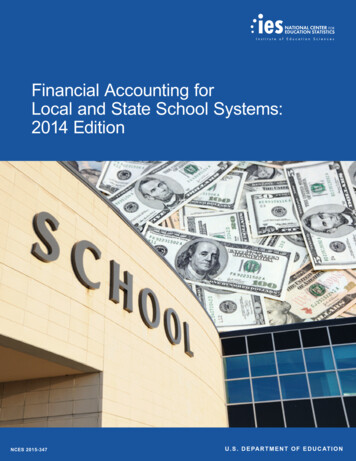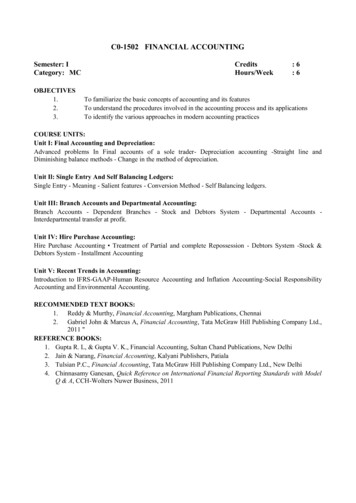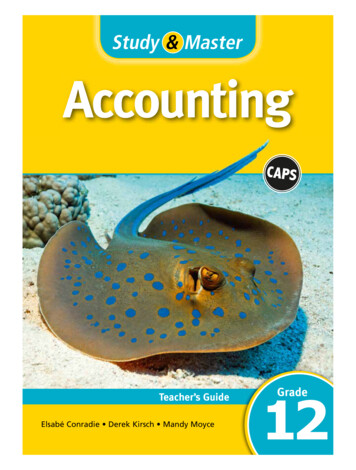
Transcription
Financial Accounting forLocal and State School Systems:2014 EditionNCES 2015-347U . S . D E PA R T M E N T O F E D U C AT I O N
Financial Accounting forLocal and State School Systems:2014 EditionMARCH 2015Gregory S. AllisonUniversity of North CarolinaFrank JohnsonProject OfficerNational Center for Education StatisticsNCES 2014-347U.S. DEPARTMENT OF EDUCATION
U.S. Department of EducationArne DuncanSecretaryInstitute of Education SciencesSue BetkaActing DirectorNational Center for Education StatisticsPeggy G. CarrActing CommissionerThe National Center for Education Statistics (NCES) is the primary federal entity for collecting, analyzing, and reportingdata related to education in the United States and other nations. It fulfills a congressional mandate to collect, collate, analyze,and report full and complete statistics on the condition of education in the United States; conduct and publish reports andspecialized analyses of the meaning and significance of such statistics; assist state and local education agencies in improving theirstatistical systems; and review and report on education activities in foreign countries.NCES activities are designed to address high priority education data needs; provide consistent, reliable, complete, and accurateindicators of education status and trends; and report timely, useful, and high quality data to the U.S. Department of Education,the Congress, the states, other education policymakers, practitioners, data users, and the general public. Unless specificallynoted, all information contained herein is in the public domain.We strive to make our products available in a variety of formats and in language that is appropriate to a variety of audiences.You, as our customer, are the best judge of our success in communicating information effectively. If you have any comments orsuggestions about this or any other NCES product or report, we would like to hear from you. Please direct your comments toNCES, IES, U.S. Department of Education1990 K Street NWWashington, DC 20006-5651March 2015The NCES Home Page address is http://nces.ed.gov.The NCES Publications and Products address is http://nces.ed.gov/pubsearch.Mention of trade names, commercial products, or organizations does not imply endorsement by the U.S. Government.Suggested CitationAllison, G.S. (2015). Financial Accounting for Local and State School Systems: 2014 Edition (NCES 2015-347). U.S. Departmentof Education, National Center for Education Statistics. Washington, DC: U.S. Government Printing Office.For ordering information on this report, write toED Pubs, U.S. Department of EducationP.O. Box 22207Alexandria, VA 22304or call toll free 1-877-4ED-Pubs or order online at http://www.edpubs.gov.Content ContactFrank Johnson202-502-7362frank.johnson@ed.gov
PrefaceThis handbook is one in a series of data handbooks published by the National Center forEducation Statistics (NCES). It continues a half-century’s tradition of sharing the best practicesin data collection and reporting with the schools, school districts, and state agencies that are ourpartners in providing good information to manage, assess, and guide elementary and secondaryeducation.In addition to this volume, NCES has produced the Handbooks Online tool to improve theconsistency of data definitions and data maintenance, so that education data can be moreaccurately aggregated and analyzed. Handbooks Online contain data items, definitions, and asystem of data item codes at the student, staff, school, school district, and state levels. TheHandbooks Online tool is updated as needed and is available athttp://nces.ed.gov/programs/handbook/.The data handbooks do not include every possible data element. They are intended, rather, as aset of data element definitions and suggestions for structuring a report or an electronic recordsystem. However, every attempt has been made to include all of the data elements routinelyrequired for federal education reporting. The rationale for this is that if these items are part of acomprehensive information system used for the daily management of schools and districts, theycan be reported with minimal additional burden on teachers and principals.NCES and representatives of state and local education agencies, as well as members of theresearch and statistical communities, have worked together through the National CooperativeEducation Statistics System to improve the quality and comparability of data used for educationpolicy decisions at all levels of government. This handbook, like the other data handbookspublished by NCES, was written through the efforts of education professionals from a range ofbackgrounds. Their input ensures that such products are useful for managing the daily business ofschools and districts as well as for identifying the information needed for program monitoringand statistical purposes.iii
Page intentionally left blank.iv
AcknowledgmentsThe 2014 edition of Financial Accounting for Local and State School Systems updates the 2009and 2003 editions of the handbook. The 2003 edition was the work of the NCES National Forumon Education Statistics, Core Finance Data Task Force. That task force systematically rewrotenearly the entire text, incorporating new chapters and reviewing and revising the account codestructure and account code definitions. The 2009 edition of the handbook incorporated changesresulting from the issuance of GASB Statements 40 through 47. This edition incorporateschanges resulting from the issuance of GASB Statements 48 through 70.NCES would like to thank all of the accountants and data coordinators in the state educationagencies who have used previous editions of the handbook and have provided advice onimproving and updating this edition. In particular, NCES would like to thank Peggy O’Guin andChristine Davis of the California State Department of Education; Su McCurdy and Janice Evansof the Iowa State Department of Education; Glenda Rader of the Michigan State Department ofEducation; and Vaughn Altemus of the Vermont State Department of Education.v
Page intentionally left blank.vi
ContentsPagePreface . iiiAcknowledgments . vChapter 1: Introduction . 1Major Changes and Chapter Highlights . 1Chapter 2: Financial Reporting Within a System of Education Information . 6Background . 7Useful Applications of Education Information . 9Users of School Finance Information . 11Summary . 12Chapter 3: Budgeting . 14Budgetary Objectives . 15Budgetary Approaches . 16Operating Budget Responsibilities and Guidelines . 20Financial Forecasting and Planning . 22Planning for Annual and Multiyear Construction and Grant Programs . 24Budgets for Multiyear Construction Projects . 24Preparation of Construction Project Budgets and Related Financing . 25Summary . 25Chapter 4: Governmental Accounting . 26Governmental GAAP Hierarchy . 28Measurement Focus and Basis of Accounting . 30Fund Structure . 31Internal Control Structure . 33Other Issues Affecting Educational Entities . 39Conclusion . 40Chapter 5: Financial Reporting. 41Financial Statement Elements . 42Assets . 42Deferred Outflows and Inflows of Resources . 60Liabilities . 62Fund Balance/Net Position. 69Revenues . 72Fund Financial Statements—Reporting of Expenditures/Expenses . 75Government-Wide Statements—Reporting of Expenses . 78Financial Statements . 79Conclusion . 94Chapter 6: Account Classification Descriptions . 96Fund Classifications . 97Program. 100Balance Sheet/Statement of Net Position . 103vii
Classifications of Revenue and Other Financing Sources . 112Classifications of Expenditures. 123Function . 123Object. 135Project/Reporting. 148Level of Instruction . 149Additional Classifications . 150Chapter 7: Cost Accounting and Reporting for Educational Programs . 151The Expanding Need for Greater Detail in Financial Reporting . 151Concepts of Program Cost Reporting by School . 151Analysis of Reported Costs . 153The Program Cost Reporting Structure . 153Use of Cost Reporting Software With Existing Data Systems . 156Direct Costs . 156Indirect Costs . 156Summary of the Annual Program Cost Reporting Process . 157Analysis of Cost Reports . 158Conclusion . 158Chapter 8: Activity Fund Guidelines. 159Types of Activity Funds and Their Proper Classification. 159Controls for Establishing and Maintaining Activity Funds . 161Preparation and Review of Monthly Activity Fund Reports . 164Summary . 167References . 169Appendix A—Summary of Account Code Changes Since 2009 .A-1Appendix B—Other Resources . B-1Appendix C—Glossary of Acronyms . C-1Appendix D—Illustrative Financial Statements for an Independent School District .D-1Appendix E—Criteria for Distinguishing Equipment From Supply Items . E-1Reasons for Distinguishing Between Supplies and Equipment . E-2The Disadvantages of a Supply/Equipment List . E-3Criteria for Distinguishing Between Supply and Equipment Items . E-3Distinguishing Between Built-In and Movable Equipment . E-4Selecting the Level of Control for Supplies and Equipment. E-6Index . Index-1viii
List of ExhibitsExhibitsPage1.Measurement focus and basis of accounting for financial statements . 262.Financial statement components and primary user groups . 373.Straight-line depreciation method . 494.Accumulated depreciation method. 495.Net position classification . 636.Classification of revenues . 667.Contents of a Comprehensive Annual Financial Report (CAFR). 728.Measurement focus and basis of accounting for financial statements . 789.Important distinctions between MD&A and letter of transmittal . 8410.Program cost report format . 14511.Cost analysis example . 14812.Lines of authority for student activity funds . 152Summary of Account Code Changes Since 2003A-1.Changes to account code descriptions . A-2A-2.New account codes. A-2Basic Financial StatementsD-1.Sample independent school district statement of net position: As of June 30, 20X2 . D-3D-2.Sample independent school district statement of activities: For the year endedJune 30, 20X2 . D-4D-3.Sample independent school district balance sheet, governmental funds:As of June 30, 20X2. D-5D-4.Sample independent school district statement of revenues, expenditures, andchanges in fund balances, governmental funds: For the year ended June 30, 20X2 . D-6ix
List of Exhibits—ContinuedExhibitsPageD-5.Sample independent school district reconciliation of the governmental fundsstatement of revenues, expenditures, and changes in fund balances with thedistrict-wide statement of activities: For the year ended June 30, 20X2 . D-7D-6.Sample independent school district statement of net assets, proprietary funds:As of June 30, 20X2. D-8D-7.Sample independent school district statement of revenues, expenses, andchanges in fund net position, proprietary funds: For the year ended June 30, 20X2 . D-9D-8.Sample independent school district statement of cash flows, proprietary funds:As of June 30, 20X2. D-10D-9.Sample independent school district statement of fiduciary net position:As of June 30, 20X2. D-11D-10.Sample independent school district budgetary comparison schedule for thegeneral fund: For the year ended June 30, 20X2 . D-12Criteria for Distinguishing Equipment From Supply ItemsE-1.Criteria for Distinguishing Equipment From Supply Items . E-5x
Chapter 1: IntroductionThe 2014 edition of the National Center for Education Statistics (NCES) handbook FinancialAccounting for State and Local School Systems reflects changes in accounting and financialreporting guidance that have been made since the 2009 edition was released. The handbook willreceive periodic updates to ensure that contemporary issues are regularly incorporated into theaccounting guidance for schools. The online version can be found athttp://nces.ed.gov/pubsearch/pubsinfo.asp?pubid 2014-347.This handbook represents a national set of standards and guidance for school system accountingthat incorporates relevant guidance from the Governmental Accounting Standards Board (GASB)Statements (through Statement 70). Its purpose is to help ensure that public elementary andsecondary education finance data are reported comprehensively and uniformly. To beaccountable for public funds and to assist education decisionmakers, all school financial reportsneed to contain the same types of financial statements for the same categories and types of funds.This revised and restructured guidance focuses on the following: defining account classifications that provide meaningful financial management informationfor its users; complying with Generally Accepted Accounting Principles (GAAP) established by GASB; recognizing the changes that have taken place in technology, safety, and security; and supporting federal reporting requirements.The statutes and regulations regarding school accounting differ from state to state. Thesedifferences may require states, school districts, and schools to adapt the guidance that appears inthis handbook. However, consistent practices and terminology are critical to accountability forgovernment funds. The accounting methods used must be capable of producing financial reportsthat conform both with GAAP and with the legal requirements of each state, if they differ.Guidance regarding the use and reporting of finance data can be found in the Forum Guide toCore Finance Data Elements (National Forum on Education Statistics 2007). That publicationincludes a review of the federal datasets containing finance data, commonly reported financemeasures, and performance indicators.Major Changes and Chapter HighlightsThe 2014 edition of the handbook maintains the general style and format of the 2009 edition. Thefollowing is a summary of the topics covered in each chapter.1
Chapter 2: Financial Reporting Within a System of Education InformationThis discussion of the role of the fiscal data system in education management and policymakingincludes an examination of the advantages of aligning the fiscal data system with acomprehensive information system as well as an overview of the users of school financeinformation.Chapter 3: BudgetingThis chapter describes budgeting methods and budget preparation, including capital budgetingfor governmental entities. It addresses budgetary approaches and responsibilities, financialforecasting, and special budgeting practices, such as those for multiyear construction projects.Chapter 4: Governmental AccountingThis chapter provides descriptions of accounting systems and requirements for governmentalaccounting systems to provide information on internal control practices, as well as theinformation on fund-level reporting and government-wide reporting required by GASBStatement 34 and related statements.Chapter 5: Financial ReportingThis chapter outlines the major financial statement elements and reporting requirements forgovernments. As in previous editions, it includes the most significant additions andmodifications to financial reporting that are covered in the handbook. In particular, there aresignificant changes related to GASB Statement 51, Accounting and Financial Reporting forIntangible Assets; GASB Statement 54, Fund Balance Reporting and Governmental Fund TypeDefinitions; and GASB Statement 65, Items Previously Reported as Assets and Liabilities. Thesestatements will have the most extensive impact on school districts of any of the GASBstatements issued since the 2009 edition.GASB has issued a significant number of new statements that have either become effective sincethe publication of the 2009 edition or that will become effective within the next several years.The statements with direct relevant impact on governmental entities that are referenced in thisedition are as follows: GASB Statement 51, Accounting and Financial Reporting for Intangible Assets GASB Statement 52, Land and Other Real Estate Held as Investments by Endowments GASB Statement 53, Accounting and Financial Reporting for Derivative Instruments GASB Statement 54, Fund Balance Reporting and Governmental Fund Type Definitions GASB Statement 55, The Hierarchy of Generally Accepted Accounting Principles for Stateand Local Governments GASB Statement 56, Codification of Accounting and Financial Reporting GuidanceContained in the AICPA Statements on Auditing Standards2
GASB Statement 57, OPEB Measurements by Agent Employers and Agent MultipleEmployer Plans GASB Statement 61, The Financial Reporting Entity: Omnibus—An amendment of GASBStatements No. 14 and No. 34 GASB Statement 62, Codification of Accounting and Financial Reporting GuidanceContained in Pre-November 30, 1989 FASB and AICPA Pronouncements GASB Statement 63, Financial Reporting of Deferred Outflows of Resources, DeferredInflows of Resources, and Net Position GASB Statement 64, Derivative Instruments: Application of Hedge Accounting TerminationProvisions—An Amendment of GASB Statement No. 53 GASB Statement 65, Items Previously Reported as Assets and Liabilities GASB Statement 67, Financial Reporting for Pension Plans—An amendment of GASBStatement No. 25 GASB Statement 68, Accounting and Financial Reporting for Pensions—An amendment ofGASB Statement No. 27Although all of these statements have the potential to affect the accounting and financialreporting practices of the governmental entities that use this handbook, those with the mostsignificant effects—and which are therefore highlighted in this edition—are as follows: GASB Statement 51 provides definitive guidance on the accounting and financial reportingof intangible assets. Although much of the guidance simply codifies what had beengenerally accepted practice, it marks the first time that governmental GAAP directlyaddresses the specific issues of internally generated assets. (Effective for financialstatements beginning after June 15, 2009.) GASB Statement 53 provides accounting and financial reporting guidance forgovernmental entities that have derivative instruments. The vast majority of governmentalentities that utilize this guide as a resource will, in all likelihood, not be affected by thisstandard, but it should be noted as a potential resource if circumstances warrant. (Effectivefor financial statements after June 15, 2009.) GASB Statement 54 has the most significant impact on governmental entities of any of thestandards identified. Any governmental entity that reports governmental funds is affectedby the requirements of this standard. The primary effects are twofold. First, the officialdefinitions of the general fund, special revenue fund, debt service fund, capital projectsfund, and permanent fund have been clarified. In some cases, these changes may necessitate3
a change in the use of certain fund types by some governmental entities. The second, andmore far-reaching, impact of this statement is the complete change in the fund balanceclassifications used by governmental fund types. The new approach classifies fund balancebased on constraints imposed on the resources reported in governmental funds, as opposedto the historical approach of classifying fund balance based on its availability forappropriation. (Effective for financial statements beginning after June 15, 2010.) GASB Statement 55 codifies the governmental GAAP hierarchy within the GASBliterature. While this does not change the governmental GAAP hierarchy, it is no longerreferenced only within the American Institute of Certified Public Accountants (AICPA)auditing standards. GASB Statement 61 is primarily an update of GASB Statement 14, The FinancialReporting Entity, and modifies certain requirements for inclusion of component units in thefinancial reporting entity. GASB Statement 61 is required to be implemented for fiscalperiods that begin after June 15, 2012, although earlier implementation is encouraged. Fororganizations that previously were required to be included as component units by meetingthe fiscal dependency criterion, a financial benefit or burden relationship must now alsoexist between the primary government and the organization for it to be included as acomponent unit. Also, the standard slightly amends the criteria for blending componentunits. For component units that are blended because their governing bodies are“substantively the same,” there is a further requirement that either (1) the primarygovernment and the component unit have a financial benefit or burden relationship, or (2)management (not the elected officials) of the primary government have operationalresponsibility for the activities of the component unit. In addition, blending will now berequired if the resources of the primary government will be used to repay all or a substantialportion of the component unit’s outstandin
Accounting for State and Local School Systems reflects changes in accounting and financial reporting guidance that have been made since the 2009 edition was released. The handbook will receive periodic updates to ensure that contemporary issues are regularly incorporated into the accounting guidance for schools. The online version can be found at











